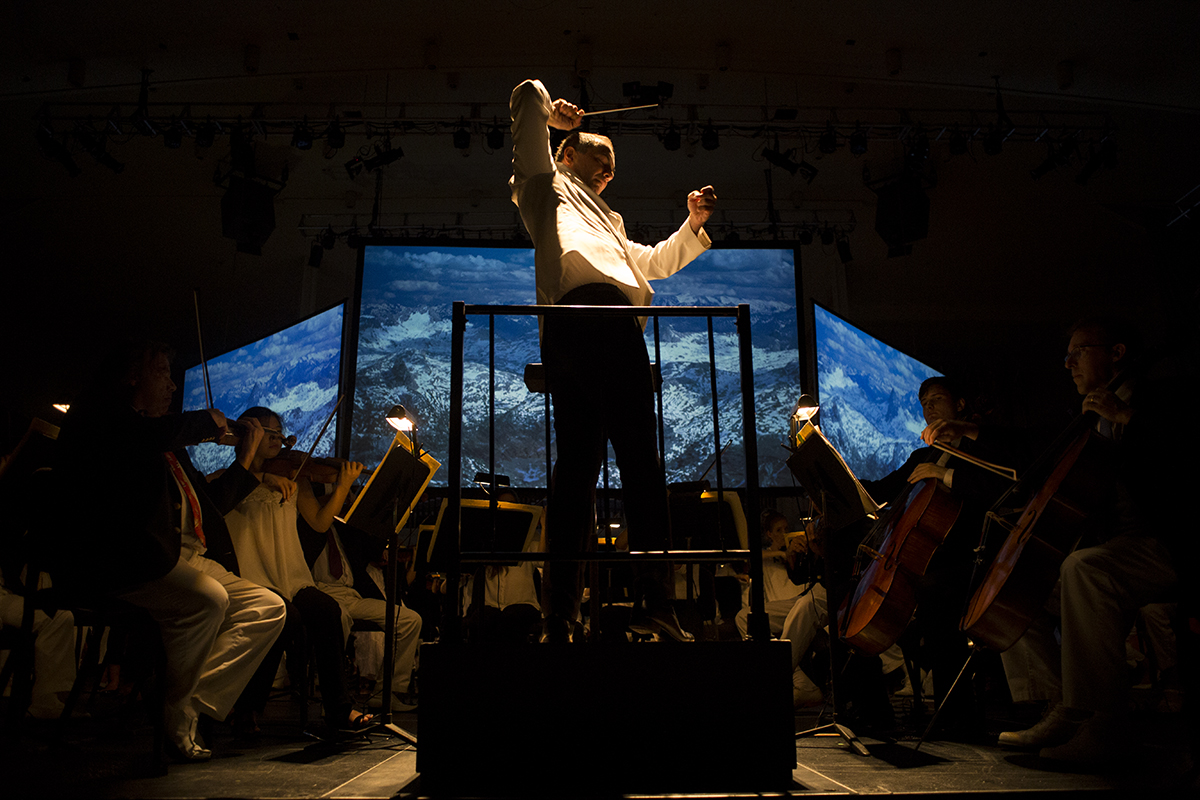By most reckonings the most lavishly scored purely instrumental work in the standard repertoire, Richard Strauss’ “An Alpine Symphony” — a recounting in music of a daylong Alpine expedition the composer undertook as a boy — is certainly among the most explicitly pictorial. Which makes it either perfect fodder for visual enhancement or an entirely self-sufficient score that needs nothing of the type.
Tobias Melle, a Munich-based photographer and cellist, firmly adheres to the former philosophy and has made a career of matching large-scale masterpieces with high-definition visuals. “An Alpine Symphony in Images” earned a substantial ovation Saturday night in the Amphitheater, though surely for both the photography and the superb performance by the combined Chautauqua Symphony Orchestra and the 2016 Music School Festival Orchestra — 162 players strong — under the baton of conductor Rossen Milanov.
Before I expand with great enthusiasm on the audio dimension of this evening I should describe what we actually saw on three screens above the orchestra. Slide show might sound a little prosaic, but this was the essence of it. There were many, many images of the Bavarian Alps, where Strauss built a home in 1908 (and completed “An Alpine Symphony” seven years later).
Most of the photos were of majestic peaks, but there were also rolling pastures and closeups of flowers, ferns and leaves. Only on occasion — most notably through the “Thunder and Storm” sequence, accompanied by rapidfire forks of lightening — did the images veer toward a level of integration with the music that could be safely described as cinematic.
There was also some variation in photographic style, between the opposite poles of the mystical and the literal. One inspired touch was the use of a misty eclipse to represent the “Calm Before the Storm.” At other points — the blooming meadows and on the Alpine pastures — I found myself reflecting on how flowers are flowers, a chalet is a chalet and a cow is a cow. I like them all well enough, but I like their musical analogs better.

Melle (who was in the Amphitheater and on the job) interpreted “An Alpine Symphony” correctly as a cycle from night to night rather than from sunrise to sunset. The initial and concluding image was of a brilliant full moon. At the waterfall was more spray than cataract. Again, I preferred Strauss’ brilliant musical rendering.
How to manage the literal zenith of the excursion was obviously a considerable challenge — for Strauss as well as Melle. The composer had a spectrum of instruments, key relations and dynamic levels at his disposal. Melle had a collection of more or less equally stunning Alpine vistas. After dazzling us in the early going, how could he possibly raise the ante?
None of this is to say that “An Alpine Symphony in Images” in any way attenuated the joy of the performance. For many in the crowd who did not know the work — which is very costly to perform without student reinforcements — it clearly constituted an aid to pleasure and a window into the mind and environment of the composer.
It was also part of a growing trend in the symphonic world. Straight-up symphonic concerts are certainly still among us, but visual enhancements are making inroads. Bach’s “Passions” in Europe now seem to be staged as often as they are given in unadorned form. Last year the San Francisco Symphony gave a staged and video-enhanced performance of no less staggering a masterpiece than Beethoven’s “Missa Solemnis.” “Like many ambitious works written for large forces, it can strangle on its own complexity and majesty,” the conductor Michael Tilson Thomas wrote by way of explanation in a program note.
Melle himself has created image packages for Beethoven’s Ninth Symphony and Tchaikovsky’s Fifth. Interestingly, he regards Mozart’s music as too celestial to be given this treatment.
My outlook is more case-by-case than doctrinaire. If visual enhancements give more people exposure to great music, who can complain? And how purist can we afford to be when Stravinsky’s great ballets are performed 49 times out of 50 without the visual dimension they were meant to enhance?
All the same, as much as I enjoyed this presentation, it was still primarily on account of the radiant strings, glowing brass, picturesque woodwinds and vivid percussion as assembled into a great narrative arc by Milanov, a conductor whose gestures were both graceful and precise. It would be difficult to recount all the individual efforts but a nod is surely owing to principal clarinet Eli Eban for his peaceful solo at the Summit. Thanks to Strauss: It takes a genius to know that repose is needed at such moments.
The printed program somewhat underbid the length of performance, which I clocked at 54 minutes, not 47. “Dream in White on White” (1992) by John Luther Adams was estimated to last 17 minutes, but duration hardly mattered in this spectacularly uneventful exercise in minimalism for string orchestra, string quartet and harp. The handsome tone of the front four kept me alert. Most of the people in my immediate vicinity were asleep. Here is a score that cries out for visual enhancement.
Arthur Kaptainis is the classical music critic for the Montreal Gazette and formerly for the National Post. He also writes for Opera Canada and Musical Toronto, and is heard from time to time on CBC Radio Two.





